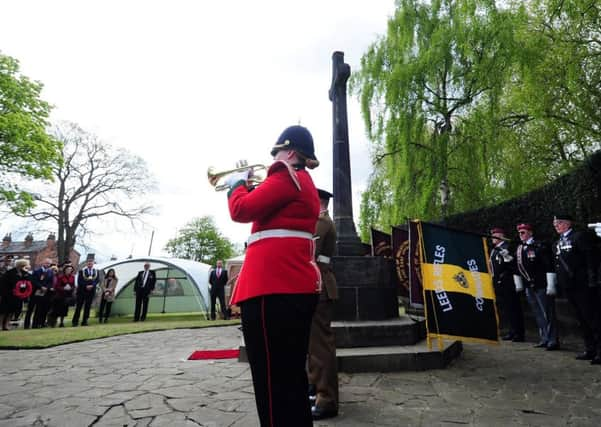YP Letters: Wartime tale of bravery and tragedy


I THOUGHT I would tell you the story of W Edgar Potts – killed in action on April 13, 1918 – on the centenary of his death.
Edgar was born in Leeds in 1891, the son of Joseph Potts, a member of the well-known Leeds clock-making family, and Sarah Anna Burton Potts (née Middleton). He was educated at Leeds Modern School and Leeds Grammar School.
Advertisement
Hide AdAdvertisement
Hide AdIn 1909 he joined the West Yorkshire Regiment (Leeds Rifles TA), until he decided in 1913 to emigrate to Alberta in Canada and take up farming. In August 1914 he enlisted into the Alberta Hussars, anticipating that he would be sent to Europe to participate in the war.
When it transpired that his regiment was not going to Europe, he returned to England in January 1915 and rejoined, as a private, the 8th Battalion West Yorkshire Regiment (Leeds Rifles). In 1916 he was sent to France with the 2/8th Bn. after being promoted to the rank of Lance Sergeant.
He was awarded a Military Medal for bravery and promoted to Sergeant shortly afterwards. The award was gazetted on May 11, 1917, and the citation in the regimental war diary reads: “On the morning of 19th February 1917, in front of Beaucourt Trench, this NCO was in charge of an advance post which was attacked by the enemy which, however, he successfully defended with loss to the raiders.Throughout the whole incident he showed great coolness, judgement and initiative and so saved the situation.”
In January 1918, he returned to England to be married to Winifred Middleton on March 27 and receive officer training.
Advertisement
Hide AdAdvertisement
Hide AdTheir marriage lasted just 17 days. He received a commission in the 5th Battalion West Yorkshire Regiment and returned to the Western Front in April 1918. He was there when the Lys offensive (Operation Georgette) commenced and on April 13, 1918, 2nd Lieutenant Potts led his platoon into action against a heavy German attack and at a critical moment, while operating a Lewis machine gun, was killed by an enemy shell.
As a postscript, his widow married in 1923 Arthur Scipio Mussabini, whose father – Scipio Africanus Mussabinni (known as Sam) – was the trainer for Harold Abrahams when he won the 100 metres in the 1924 Paris Olympics (as depicted in the film Chariots of Fire) and the author of books on athletics and training techniques.
Edgar has no known grave and is commemorated on the Ploegstreet Memorial not far from Ypres. He is also remembered on the Leeds Rifles memorial in St Peter’s Church, Leeds, and on the Headingley War Memorial. His name is on the rolls of honour for both Leeds Modern School and Leeds Grammar School. His name appears in the Roll of Honour published by The Yorkshire Post and Leeds Intelligencer on May 6, 1918.
His two cousins, Robert Gowland Potts and Charles Harold Potts, both served during the war and survived.
From: Barry Geldard, Hebden Bridge.
Advertisement
Hide AdAdvertisement
Hide AdA RECENT article in The Yorkshire Post brought to mind an event in the area during the Second World War.
In February 1940, the pilots of three Hurricane fighters intercepted and shot up a German Heinkel bomber which had been attacking shipping a couple of miles off the Yorkshire coast.
The bomber crash landed close to a farm near Whitby and the surviving crew members were escorted to hospital.
It was the first enemy aircraft to be shot down over England during the Second World War.
Advertisement
Hide AdAdvertisement
Hide AdOne of the Hurricane pilots was Squadron Leader Peter Townsend, who later became an equerry to King George VI. This brought him into close contact with Princess Margaret, sister of our present Queen.
If we are to believe the national Press of the day, romance blossomed and marriage was considered possible.
However, protocol and government interference decreed that there was no possibility of a divorced commoner being allowed to marry into the Royal family.
No doubt recrimination over the saga of the Duke of Windsor marrying the twice-divorced American, Wallis Simpson, still rankled in Royal circles.
Advertisement
Hide AdAdvertisement
Hide AdThe forthcoming wedding of Prince Harry to American divorcee Meghan Markle illustrates how times have changed for the better.
Moss used to dress wounds
From: Molly Preston, Austwick.
READING Ben Barnett’s article in Country Week mentioning peat bogs reminded me of the sphagnum moss collecting from Austwick Moss in wartime.
The bog is south of Austwick. Originally each house in Austwick was allocated a piece of land for peat extraction. The peat, the most common source of fuel at that time, was dug into “turfs” and stacked to dry.
It was then transported home by cart to the peat house ready for burning on the open fire. When the peat was replaced by coal, the peat pits filled with water and water-loving plants took over, including sphagnum moss (which is highly absorbent).
Advertisement
Hide AdAdvertisement
Hide AdExpenditions went from school under the guidance of Chris Cheetham, a local naturalist, to pull out the moss, hang it on the walls to dry, collect it into sacks, and it was delivered to hospitals as medical dressings, as cotton wool was no longer available. We loved the expeditions to the moss, Chris Cheetham showed us the unusual flora and fauna.
Wrong view
From: Jean Cew-Tetlaw, Mytholmroyd.
IN the Magazine (The Yorkshire Post, April 7), a photo was published of “Stoodley Pike”. This was supposedly one of Robin Tuddenham’s favourite views. Unfortunately this wasn’t Stoodley Pike but a stone obelisk War Memorial in Pecket Well, Hebden Bridge. It was built echoing the form of the original Stoodley Pike, which can be seen from this monument.